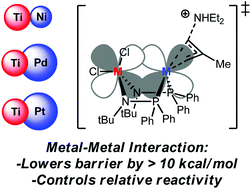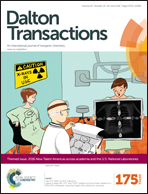Allylic amination reactivity of Ni, Pd, and Pt heterobimetallic and monometallic complexes†
Abstract
Transition metal heterobimetallic complexes with dative metal–metal interactions have the potential for novel fast reactivity. There are few studies that both compare the reactivity of different metal centers in heterobimetallic complexes and compare bimetallic reactivity to monometallic reactivity. Here we report density-functional calculations that show the reactivity of [Cl2Ti(NtBuPPh2)2MII(η3-methallyl)] heterobimetallic complexes for allylic amination follows M = Ni > Pd > Pt. This reactivity trend was not anticipated since the amine addition transition state involves MII to M0 reduction and this could disadvantage Ni. Comparison of heterobimetallic complexes to the corresponding monometallic (CH2)2(NtBuPPh2)2MII(η3-methallyl) complexes reveals that this reactivity trend is due to the bimetallic interaction and that the bimetallic interaction significantly lowers the barrier height for amine addition by >10 kcal mol−1. The impact of the early transition metal center on the amination addition barrier height depends on the late transition metal center. The lowest barrier heights for this reaction occur when late and early transition metal centers are from the same periodic table row.

- This article is part of the themed collection: New Talent: Americas

 Please wait while we load your content...
Please wait while we load your content...